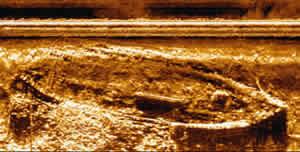
Hunt Is On for Shipwrecks from War of 1812
Two centuries after a naval arms race introduced more and more warships to the Great Lakes, the search is on for the sunken remains of two of the ships that fought in the War of 1812.
Researchers are digging the depths of Lake Ontario for the remains of a frigate called the Mohawk and an unnamed U.S. gunboat designed for amphibious attacks and harassing British shipping.
"Quite a few ships have been excavated around the Great Lakes in the U.S. and Canada from the War of 1812, but there are many that haven't been found," underwater archaeologist Ben Ford said.
There is good reason to believe these ships lie in sediment near each other, making them excellent targets for a summer excavation, Ford told OurAmazingPlanet.
Left to rot
Ford and his colleague Katie Farnsworth, both from Indiana University of Pennsylvania, are surveying Black River Bay, in the northeast corner of Lake Ontario, to find the two shipwrecks. [Image Gallery: Shipwreck Alley's Sunken Treasures ]

"Basically the geography worked out and made sense to look at both of them at the same time," Ford said. Another ship, the Jefferson, was found and studied in 1984. If the team is now able to find the Mohawk and the gunboat, between them and the Jefferson "we could have a decent spectrum of the American ships on Lake Ontario."
Sign up for the Live Science daily newsletter now
Get the world’s most fascinating discoveries delivered straight to your inbox.
When the conflict with the British ended in 1814 with the signing of the Treaty of Ghent, many ships that had cruised and fought on the Great Lakes were abandoned. As Ford describes it, the war had been an arms race for both sides without a lot of major battles.
"Leaders on both sides wanted to have a clear advantage; [they] couldn't afford to lose, so they kept sending ships out," he said. When the war ended, those ships were too big to be useful for moving cargo or people, so they just sat around ready to be trotted out again in case of a conflict.
"So they began to rot. A number of them sank to the bottom, and others were stashed in Sackets Harbor," a lakeside harbor in New York state that hosted a Navy shipyard, Ford said. Eventually, the remaining ships were moved, burned or intentionally sunk.
Shipwreck sonar search
The current work, which is supported by the National Geographic Society, involves both surveying and excavating in 50 feet (15 meters) of water. The floor of the harbor is sand and silt, bordered by rock ledges, making an interesting time of digging.
Ford says the teams are using remote sensing with sonar to create an acoustic picture of the bottom of the lake, as well as a magnetometer to measure minute changes in the magnetic field, which could reflect the presence of a ship .
If they find the two wrecks, the researchers plan to return next summer with more equipment to build a better picture of the past.










